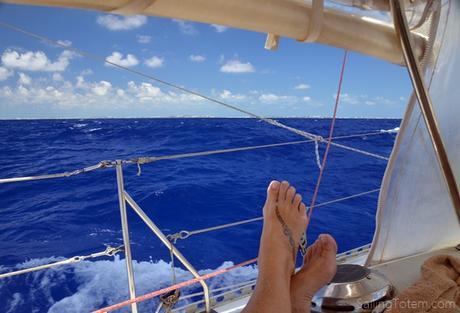
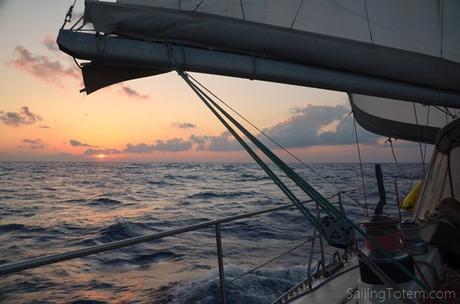
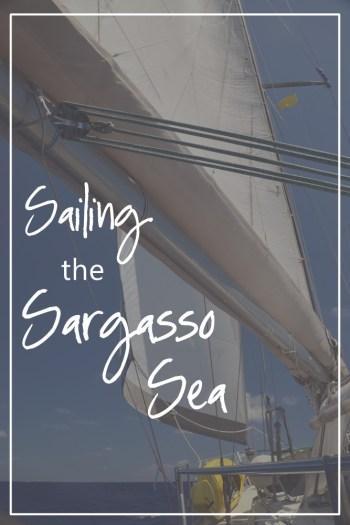
Passage metrics
- Distance: 872 nautical miles
- Duration: 5 days 4 hours
- Seas: 1-2 meters
- Typical breeze: 15-25 kts true
- Max wind speed: 35 knots (squall)
- Number of times reefed/unreefed: lost count
- Diesel burned: 6 gallons (at least one of those was because we wanted warm showers, and another was doing donuts in the Bermuda lagoon waiting for room at the customs dock)
- Wind speed: 18-25 from just north of east
Weather underway
“Weather always wins” is a mantra on Totem. Watching weather patterns for weeks ahead of our passage north from St Martin to Bermuda, the pattern was for one system after another to come off the northeastern USA, eastbound across the Atlantic. Along our anticipated route, these systems delivered wind from multiple directions as the highs (or lows) rolled through, and calms between. Juggling between motoring and sailing with breezes from the ‘wrong’ direction is not a nice way to anticipate a passage of nearly 900 miles.
As the time to depart approached, the pattern shifted. Instead of winds from a broad range of the compass, we had a beautiful easterly tradewind-like breeze that stayed with us from St Martin nearly all the way to Bermuda. Since we’re fast tracking to get to the SSCA gam in Connecticut, these comfortable reaching conditions were so much better than a northbound slog.

Sunrise at sea, as the weather cleared
But weather is capricious, and the day we planned to leave a potential tropical depression started spinning up to the west, above the Bahamas. Initial reports indicated it would stay far west of our course, but when Mother Nature starts trying to build a tropical storm at the beginning of the hurricane season, sailors take note. Other models suggested second system would form to the north, directly in our path, at exactly the wrong time.
We left St Martin, and sailed north with a watchful eye. The next day, the system above the Bahamas continued to build; eventually, it became TS Bonnie, and probably rained out a few Memorial Weekend barbecues. Better for us, the probability of a system forming to the north decreased. Again I’m grateful for the ease of detailed weather data we get through PredictWind on board.
Conditions at sea
Rain bucketed down on the morning we planned to leave St Martin. At least this time all the hatches were closed so when the main was hoisted, all the water caught in the folds didn’t turn our settees into soggy sponges! The moddled gray skies at departure remained for three days. At night, a waning quarter moon offered enough light to pick out squall lines, and breaks gave occasional peeks at the stars. The Southern Cross is fading, but for a few days it bookended the nighttime skies with Polaris before slipping below the southern horizon.
Outside the squalls, the breeze typically around 20 knots apparent and just slightly forward of the beam—the highest recorded was only 35 knots. While the cells came and went in those first days,there was a whooooole lotta reefing/unreefing action on Totem.
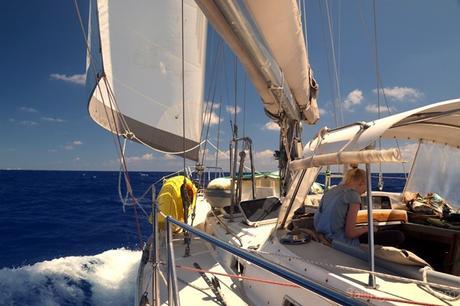
Siobhan reads in the cockpit: beautiful conditions in the home stretch to Bermuda
When the gray skies finally dissipated on our third day at sea, Niall and I lay on our backs and reveled in the crisp blue skies, watching a pair of long-tailed tropic birds trying valiantly to land on Totem’s mast. They didn’t succeed, but visited every day afterwards—could it be the same two? Where else are they going, hundreds of miles from anywhere?
During the last few days we kept the main double reefed for conservative comfort most of the time, which made for a nice ride. Seas were never more than 2 meters, but they were square and closely spaced—only 3 or 4 second periods—and now and then came together to give Totem’s hull a nasty slap. It wasn’t uncomfortable, but any bigger and it could have been.
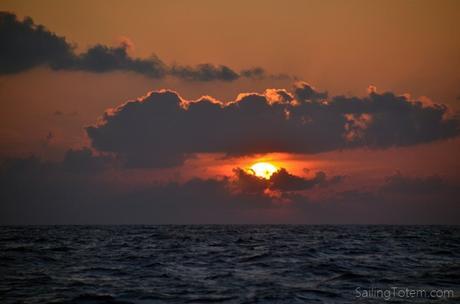
Red skies at night, sailors delight.
The latitude ticked up and the temperature dropped down, a reminder as we get north that it’s not quite summer yet. Jamie started wearing long pants on the 4th day, and Siobhan now starts every morning with her sweatshirt on! Not that it’s really all that chilly, except at night; we’re just not used to temperatures below the mid-70s anymore.
The wind faded during the last night. We expected some motoring so that’s not a big deal… but it was the first time we’d be using our spare alternator, which we had refurbished back in St Martin before Jamie installed and tested it. Unfortunately, the at-sea use did not go well, as the alternator started eating belts. Disconnecting the voltage reduced the load, and we have several spare belts, but it remains to be addressed.
Green strands of the Sargasso weed this sea is named for floated by Totem. Some of it may have gotten stuck in the intake for the aft head, because the Lavac will flush out but doesn’t want to pull seawater in any more. That’s the benefit of having two heads on board! Except there’s a valve failing in the Vacuflush in the forward head. At least we’re not reduced to using a bucket.
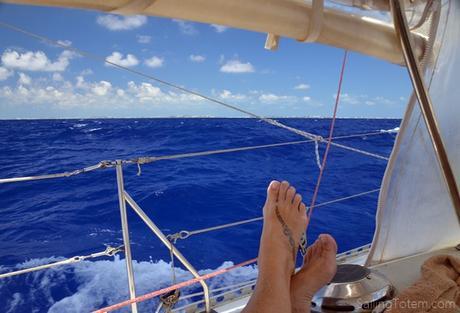
Yes, the water really is that blue.
Landfall Bermuda
Instructions are to contact Bermuda Radio over VHF from 30 miles offshore. Totem’s VHF struggles to be average and we expected we’d need to defer to one of the alternate HF frequencies instead. Imagine the surprise on board when Bermuda Radio came booming in with Securite alerts from 150 miles away! There was no problem communicating at 30 miles.
Bermuda’s low hills rose slowly: it was the brilliant whitewashed rooftops reflecting the sun that pulled it out of the low haze. It’s always a little bit of a jolt to go from wide open ocean to close navigation.
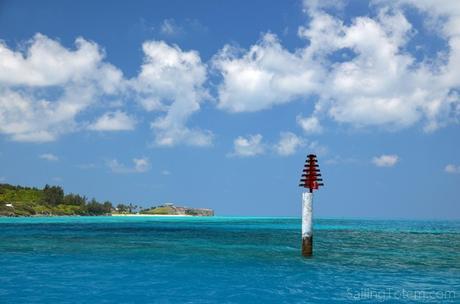
WHAT? navigation marks? this will take some getting used to.
The myriad blues of the lagoon, the prominent fort on a point near the channel into the harbor, all promise exploration and experiences. I find myself hoping the weather for the next passage takes time to set up, so we can have time to linger and enjoy.
This post is syndicated on SAILfeed.

